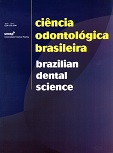Capacidade de ação solvente do eucaliptol e xilol sobre diferentes cimentos endodônticos
DOI:
https://doi.org/10.14295/bds.2006.v9i3.209Abstract
A remoção de material obturador durante o retratamento endodônico pode dificultar a limpeza dos canais radiculares. Este estudo teve como objetivo a avaliação da capacidade solvente do eucaliptol e xilol sobre cinco cimentos obturadores. Os materiais avaliados foram: AH Plus, Intrafill e os novos cimentos Roeko Seal (à base de silicone), Epiphany e Endo-Rez (à base de resina). Foram confeccionados corpos-de-prova circulares com 10 mm de diâmetro e 1 mm de espessura para cada cimento, os quais foram mantidos em estufa a 37oC por 48 h e depois divididos em 4 partes. Cada corpo-de-prova foi mantido em estufa e pesado em balança de precisão a cada 24 h até a estabilização da massa, quando a massa inicial foi determinada. Em seguida, os corpos-de-prova (n=8) foram imersos por 10 minutos nas soluções solventes avaliadas (eucaliptol e xilol). Depois de 48 h em estufa a 37ºC, foram realizadas novas pesagens a cada 24 h, até a estabilização (massa final). A diferença das massas final e inicial determinou a capacidade solvente sobre cada material. Os dados obtidos foram submetidos à análise de variância (????=0,05) demonstrando maior ação solvente do eucaliptol sobre o Intrafill, seguido pelo Epiphany e menor atuação sobre o AH Plus e Endo-Rez (p<0,05). O xilol apresentou maior ação solvente sobre o Intrafill e menor atuação sobre o AH Plus e o Endo-Rez (p<0,05). Conclui-se que os solventes eucaliptol e xilol apresentam pouca ação sobre os cimentos AH Plus e Endo-Rez, sendo mais efetivos sobre o cimento Intrafill.
Downloads
Downloads
Published
How to Cite
Issue
Section
License
Brazilian Dental Science uses the Creative Commons (CC-BY 4.0) license, thus preserving the integrity of articles in an open access environment. The journal allows the author to retain publishing rights without restrictions.
=================




























